Uverse Is Not Available at This Time Please Try Again Later
AmpliFi and UniFi are two brands endemic past networking specialist Ubiquiti. I've used the mesh networking technologies from each brand in my home for several years, and decided to write a detailed AmpliFi vs. UniFi review and comparing.
Both brands offer excellent engineering science, and determining which one is the better fit for your domicile or business ultimately boils downward to your specific requirements. My goal with this article is to equip you with enough knowledge nearly each brand and the major differences between them to make an informed buying decision.
How My Network Infrastructure Evolved
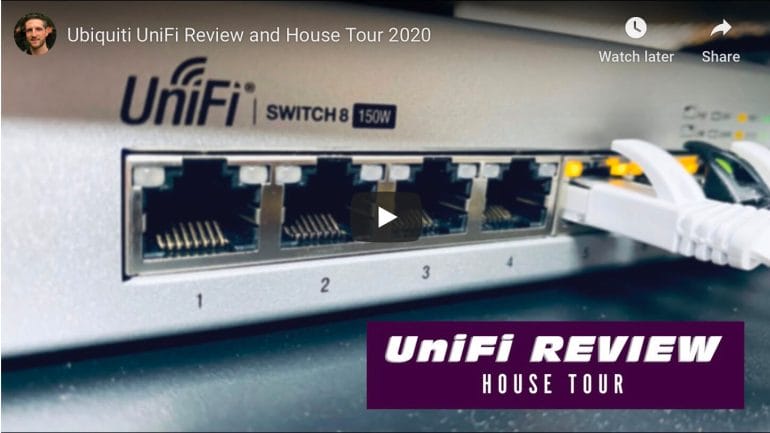
I used to have several Apple tree AirPort Extreme base of operations stations to support my network infrastructure. But when Apple decided to exit the router business, I had to look for alternatives.
After doing intensive research and looking at a dozen different options, I decided to go with AmpliFi. Later I switched to UniFi, and I'll explain the reasons behind that decision in this commodity.
In a nutshell, AmpliFi is incredibly simple to install and configure, requiring on boilerplate five minutes or less. UniFi devices require a little fleck of networking expertise — or at to the lowest degree a little bit of tech-savviness — for a successful deployment. In return, they offering dandy flexibility and expandability. Nosotros'll talk more near all that in a fleck, then stay tuned.
The 1-Router Problem
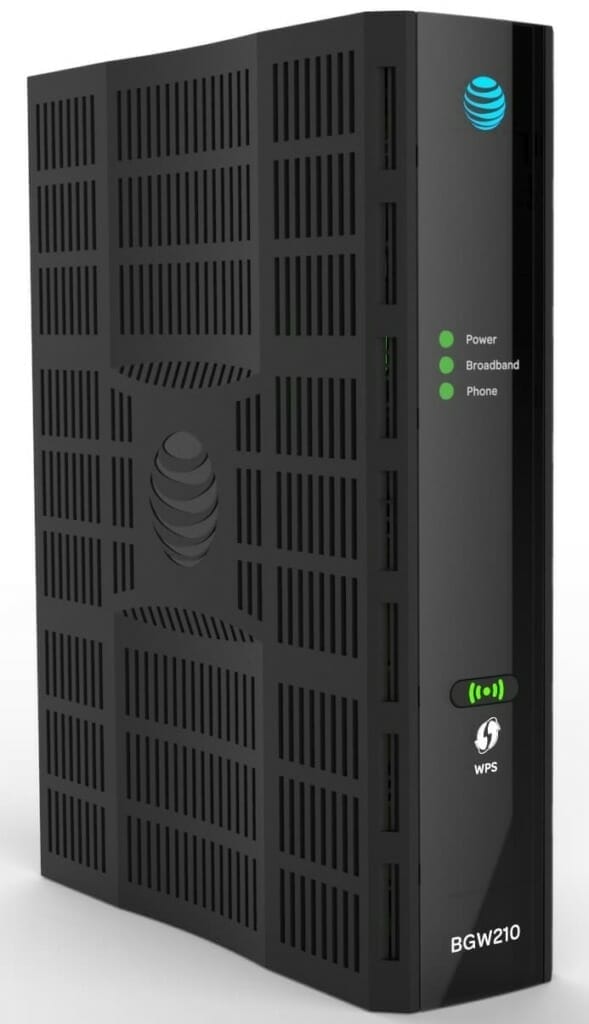
We currently alive in a three,300-square-human foot ranch-style dwelling with a rectangular layout. As shortly every bit we moved into this house, in February of 2013, I realized that a unmarried wireless router wouldn't be able to sufficiently cover the unabridged infinite.
That'south particularly true considering my cyberspace uplink enters the firm at a corner, which makes it virtually impossible to position a wireless access bespeak somewhere in the eye of the home.
Initially, nosotros tried the unmarried-router setup. Simply when constant buffering while streaming movies and Idiot box shows to our Apple tree TV in the family room became the norm — despite my AT&T fiber-optic cyberspace connection that supports speeds of about a gigabit per second — I decided to reevaluate our networking infrastructure.
As a result, I decided to run True cat 5e/6 Ethernet cables from my part — where I've placed the ISP modem — through our unfinished attic and into almost every room of the house.
That was long before I discovered AmpliFi'southward mesh-networking technology. That'south why I deployed 4 of the now-obsolete Apple AirPort Extreme base stations and daisy-chained them via Ethernet.
Y'all tin can read more about how I had set up up and configured those base stations in this article.
The advantage of wiring everything via Ethernet was that each Airport Extreme offered optimal Wi-Fi functioning in its corresponding coverage area.
And since I had joined my AirPort base stations via Ethernet, in that location was no performance loss when transferring data from one to the other. I had ane AE in my part (the master), 1 in the guest room (behind my office), and some other one in our family room (close to the Apple TV).
I kept the quaternary base station in our master bedroom, until it bankrupt and I decided non to replace it. When it became apparent that Apple would exit the networking device concern, I looked for an alternative and stumbled upon Ubiquity — the company behind AmpliFi and UniFi.
So let's start with an overview of my previous AmpliFi infrastructure earlier we accept a closer look at UniFi. Then, nosotros'll dive into how the two brands compare and dissimilarity.
My Requirements

When I decided to get rid of my Apple tree Airport Extreme base stations, I thought long and difficult nigh my requirements for the new infrastructure. I eventually settled on the following features and primal performance indicators that I wanted my new technology to meet or exceed:
- No Wi-Fi expressionless zones anywhere in the house.
- First-class Wi-Fi coverage in our family room and my home office.
- Ability to add boosted admission points, if necessary.
- Possibility to connect the nearly of import admission points via Ethernet to my main router.
- Automatic handover of devices to the strongest access point.
- Speeds in excess of 100/100 Mbps anywhere in the firm.
My Original AmpliFi Infrastructure
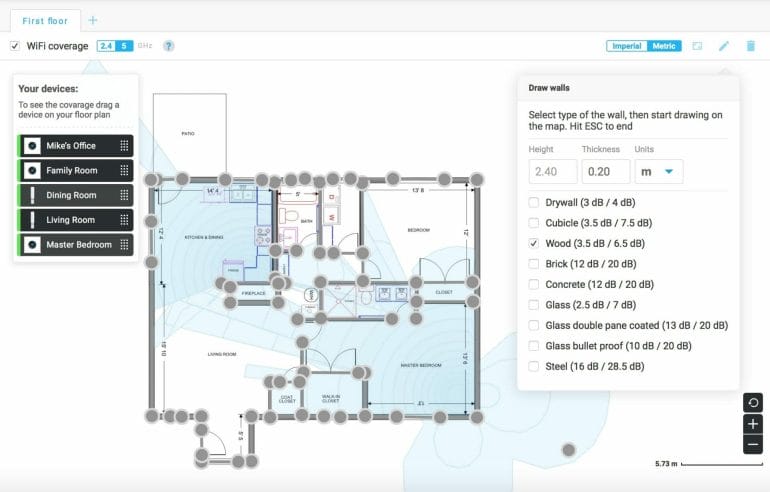
Based on the to a higher place requirements, I decided to get with the following AmpliFi hardware:
- 1 AmpliFi Hd Kit, including a router (chief) and 2 meshpoints (find on Amazon*).
- 2 AmpliFi HD standalone routers (detect on Amazon*).
Notation that at the time I showtime implemented AmpliFi, at that place was only AmpliFi Hd and none of the other options that are available now, including AmpliFi Instant, Gamer'due south Edition and AmpliFi Alien. Bank check out the link below for a detailed comparison!
I situated the main AmpliFi HD router in my office. From there, I had CAT6 Ethernet cables* running via the cranium to unlike outlets in my house, where I had plugged in the ii additional AmpliFi HD routers. In other words, I had Ethernet backhaul enabled on both of the secondary routers for the best possible operation.
Additionally, I had two wireless MeshPoints positioned in the middle of the house for additional coverage. In reality, the iii AmpliFi routers provided sufficient coverage, rendering the two mesh points somewhat unnecessary. Merely since I owned them, I decided to use them.
The spots where I had positioned ii of the AmpliFi routers were pre-adamant by the availability of the Ethernet and power outlets in the house. And while those locations weren't bad, from a coverage perspective, they weren't perfect either.
But despite the less-than-perfect positioning of my AmpliFi Hard disk drive routers, I was able to successfully blanket my habitation in Wi-Fi and everything worked every bit expected.
Why I Replaced AmpliFi With UniFi
I'm a huge fan of Ubiquiti's AmpliFi mesh networking engineering science because it provided about spotless Wi-Fi coverage throughout my abode.
So you may be wondering: if AmpliFi was working then well, why did I decide to replace it with UniFi, Ubiquiti's business-class product line?
I did not decide to abandon AmpliFi because I was dissatisfied with the technology or its performance! I consider AmpliFi the best mesh networking engineering for consumers that'due south out there, and I have recommended it to friends and family unit many times.
The principal reasons why I decided to motion from AmpliFi to UniFi were because UniFi offers:
- Greater control over advanced network settings that I can geek out on.
- Amend handover and roaming capabilities, and so that devices — such every bit mobile phones — quickly connect to the access point with the strongest Wi-Fi signal.
- Admission points that I can wall-mountain and that don't crave a dedicated ability source.
- Integration with UniFi's security cameras, which are installed in my home.
- Better scalability and upgradeability, leading to a higher return on investment.
Additionally, I was trying to remove the Arris BGW210 gateway provided past my Internet access provider (AT&T) from my network considering of its technical limitations.
Unfortunately, AT&T does not officially support customers in replacing the Arris modem with third-party routers. I was hoping that I could coerce the UniFi Security Gateway (USG) to bridge between AT&T's network and my modem, merely that didn't plow out to be feasible because the USG doesn't support hardware-accelerated bridging.
Hardware acceleration in bridge manner is a requirement to accomplish gigabit speeds.
My Original UniFi Infrastructure
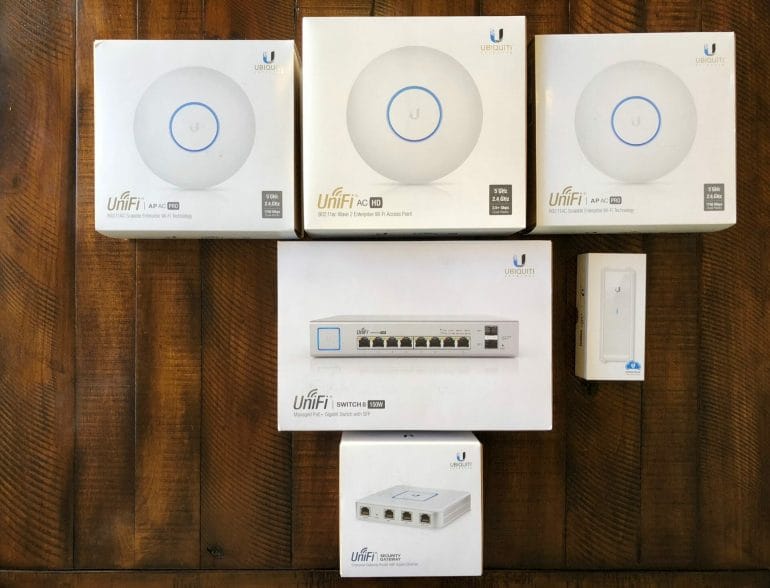
Below is a list of some of the UniFi hardware that I currently have deployed in my home. Nosotros'll be moving to a new firm in a few weeks, and I intend to add together boosted UniFi components as function of that move.
- 1x UniFi Dream Machine (UDM) — recently replaced my UniFi Security Gateway (USG).
- 2x UniFi viii-Port Switch (Usa-viii-150W).
- 1x UniFi Access Point Hard disk (UAP-AC-Hard disk drive).
- 2x UniFi Access Points PRO (UAP-Air-conditioning-PRO-U.s.a.).
- 1x UniFi Deject Key Gen ii Plus (UCK) — replaced my Gen ane Deject Key.
Initially, I had a UniFi Security Gateway (USG) and a Gen 1 UniFi Cloud Key. Nonetheless, when UniFi introduced UniFi Protect and the UniFi Dream Auto, both devices got replaced by their newer and more performant counterparts.
AmpliFi vs. UniFi Comparison
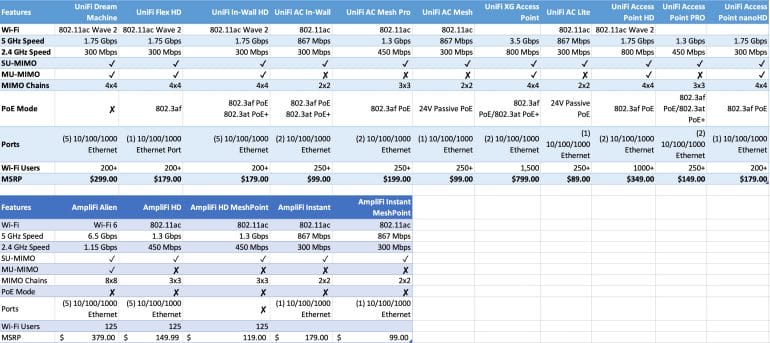
To view a larger version of the comparison chart above, simple click on it.
The rating below is based on my specific needs and requirements — for example, the power to mountain wireless admission points on the ceiling and to power them over Ethernet (PoE).
Your requirements might exist entirely different, potentially making AmpliFi the meliorate selection for you lot.
| Technology | My Rating |
|---|---|
| Apple Airport Extreme cluster (for reference) | ★★★☆☆ |
| Amplifi Hard disk drive Home Wi-Fi System | ★★★★☆ |
| UniFi Wi-Fi | ★★★★★ |
I should too notation that both AmpliFi and UniFi accept released new hardware since I initially published this review.
AmpliFi released its offset WiFi half-dozen router (the AmpliFi Alien) and UniFi released the Dream Machine (an all-in-one router and access point). The remainder of this commodity has been updated to reflect the latest hardware from both brands.
I'd as well like to point out that I've published dedicated reviews of both AmpliFi and UniFi, which each become into more than detail on their respective technology than space allows for in this post. Check them out using the links above.
Beneath is a high-level, side-by-side comparison of AmpliFi and UniFi based on the hardware that both brands offer as of December 2019 (and that are in the price range of the equipment I've used).
Update: Since publishing this article, I've migrated from the UniFi Dream Motorcar to the UniFi Dream Auto Pro (UDM PRO). Check out my full review and migration experience here.
Annotation that UniFi offers more expensive, and thus more than capable, hardware than I had the opportunity to test. As a outcome, my comparison focuses on the entry-level and non-rack-mountable UniFi hardware.
I've excluded higher-terminate hardware on purpose because I presume that readers who are trying to decide between AmpliFi and UniFi are unlikely to invest thousands of dollars in networking equipment.
| Feature | UniFi | AmpliFi |
|---|---|---|
| Wi-Fi Standard | Up to 802.11ac Wave 2 | Up to Wi-Fi 6 |
| 5 GHz Speed (Per Node) | Up to one.75 Gbps | Upwards to half-dozen.5 Gbps |
| 2.4 GHz Speed (Per Node) | Upwards to 800 Mbps | Up to 1.xv Gbps |
| Switching Functioning | 10+ Gbps | 4 Gbps |
| Routing Performance | three+ Gbps | one Gbps |
| Power-over-Ethernet | ✔︎ | ✘ |
| Advanced Routing Features | ✔︎ | ✘ |
| IPS/IDS (Speed) | ✔︎ (Up to 1 Gbps) | ✘ |
| Deployment Complexity | Moderate | Very easy |
| Cardinal Management | ✔︎ | ✘ |
| Scalability | ★★★★★ | ★★★☆☆ |
| Flexible Mounting Options | ✔︎ | ✘ |
| Upgradability | ★★★★★ | ★★★★☆ |
| Concurrent Users Per Node | i,500+ | 128 |
| Hardware Acceleration | ✔︎ | ✔︎ |
In a nutshell, UniFi offers the following advantages over AmpliFi:
- A powerful and centralized direction console.
- Better wired network performance.
- Advanced routing and firewall features, such as intrusion detection (IDS) and intrusion prevention (IPS).
- Detailed reporting and statistics.
- Flexible installation, configuration and set-up options.
As a regular consumer, you volition likely never demand all of those features to reach fantabulous WiFi coverage in your home. I consider nearly of what UniFi offers "prissy-to-have," except for the following "must-have" features — again, based on my individual requirements:
- Scalability and upgradeability: adding boosted access points, or replacing existing access points, is incredibly like shooting fish in a barrel and cost-efficient.
- Advanced routing features: while my network topology is relatively simple, I appreciate the avant-garde features UniFi offers. For example, I can stick my IoT devices into a separate VLAN for added security.
- Power-over-Ethernet: Having dedicated Ethernet connections for each access point not just ensures maximum performance, but it also allows me to mountain the UniFi access points anywhere, without having to worry about a dedicated and uninterruptible power supply.
Now that you have a basic agreement of how both technologies compare, allow's take a closer expect at the chief differences.
Ease of Use

If yous know how to plug in a power and Ethernet cable, and you know what a wireless network is, you can deploy AmpliFi — it'south that elementary.
Merely don't let that simplicity fool you. AmpliFi comes packed with avant-garde technology that you lot tin fine-tune and configure using the mobile app.
In contrast, while you don't need to be a network engineer to deploy UniFi, you may demand some understanding of how IP networks function (depending on the hardware y'all choose). I take a technical background, so I consider UniFi easy to use. Your mileage may vary.
My recommendation: If yous're similar my parents or grandparents, and y'all phone call your child or grandchildren for aid every time your figurer "doesn't piece of work," I recommend sticking with AmpliFi or making certain you get the aid you lot need to deploy UniFi (just don't telephone call me). If y'all're leaning towards UniFi, simply y'all don't want to mess around with multiple networking components, the UniFi Dream Auto (UDM) is your all-time bet to become started.
Wi-Fi Standard
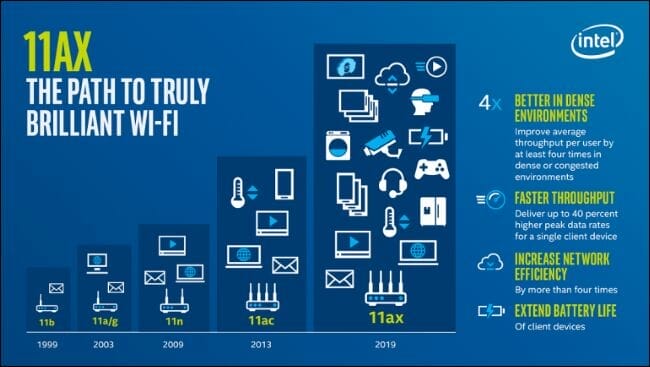
As of this writing, Wi-Fi 6 is the latest and greatest wireless standard, and it provides significant improvements over the older 802.11ac Moving ridge two (Wi-Fi 5) standard — fifty-fifty aside from the less-confusing naming convention.
Some of those improvements include:
- 4x meliorate throughput per user in dumbo or congested environments.
- Upward to 40% higher peak information rates for a single device.
- Over 4x increased network efficiency.
- Extended battery life (in client devices).
TechSpot published an fantabulous article explaining the technical details behind those improvements, so bank check it out if you lot'd like to learn more.
For now, it's important to understand that UniFi doesn't however provide support for Wi-Fi six, while AmpliFi does via its Alien all-in-one device.
While I do have around fifty client devices scattered across my dwelling, I'm nowhere near the limit of what my UniFi infrastructure can handle. What I'm trying to say is, while I'd love to introduce Wi-Fi 6 to my network, I'g not terribly upset that I can't do so yet.
My recommendation: If you're deciding betwixt AmpliFi and UniFi for your home or small business, I don't think Wi-Fi 6 support needs to be a deciding gene. Unless, of course, you're trying to become away with using a single networking device. In that case, the AmpliFi Conflicting is probable a ameliorate choice than the UniFi Dream Auto.
Wireless and Wired Performance

When it comes to per-node information throughput, y'all tin find AmpliFi and UniFi on dissimilar sides of the spectrum.
UniFi routers and switches easily outperform whatsoever AmpliFi hardware on wired connections, but the AmpliFi Alien undoubtedly offers the best wireless operation of any access point in Ubiquiti's lineup.
For me, either technology offers sufficient wired and wireless functioning. In fact, I'one thousand more often than not concerned with latency. For example, I don't desire to await for a webpage to load or a device to respond.
On the other paw, I don't operate whatever network-continued file servers in my landscape. All my storage is continued via Thunderbolt — considering it'south much faster than Ethernet — or I use cloud storage. In the latter case, my Isp uplink is the limiting factor and not my LAN.
Funnily enough, since installing the UniFi Dream Machine, I've been limited to 100/100 Mbps because of a faulty Ethernet cablevision. If it wasn't for a screenshot of a speed test I happened to run, I wouldn't have even noticed.
My recommendation: If raw LAN performance is your primary concern, stick with UniFi. If you need the best-possible wireless functioning and y'all can't utilize Ethernet, the AmpliFi Alien is currently your all-time bet — at least until UniFi releases its get-go Wi-Fi 6 access point.
Expandability and Upgradeability

While you can expand and upgrade an AmpliFi system relatively easily, there are some limitations. When I started with AmpliFi, I initially got an AmpliFi Hard disk kit consisting of one router and 2 meshpoints.
When I realized that the wireless meshpoints wouldn't requite me the functioning I was looking for, I added 2 more AmpliFi HD routers and connected them via Ethernet backhaul to the main router. That was easy and fairly straightforward, and I was simply limited past the location of my power outlets and Ethernet jacks.
The primary issue with AmpliFi is that in that location are limitations on what devices you can mix and friction match. For case, if you start your setup with an AmpliFi Conflicting router, you tin can only extend that network with more Alien routers or the newly introduced Alien MeshPoint*.
In other words, you tin can't mix AmpliFi HD with AmpliFi Conflicting in the same mesh network.
UniFi, on the other hand, offers much more flexibility because information technology allows you to mix and match whatsoever UniFi router, switch and access bespeak. Plus — and this is a biggie for me — you lot aren't express by the availability of power outlets.
Thanks to Power-over-Ethernet (PoE), you tin can install UniFi admission points anywhere you lot take an Ethernet connection, including the ceiling, walls or a piece of piece of furniture.
That also ways that as long equally I have my UniFi switches connected to an uninterruptible power supply (UPS), I don't accept to worry most my Wi-Fi shutting down when I temporarily lose power.
My recommendation: If you're looking for deployment flexibility and want to exist able to upgrade individual components over fourth dimension, UniFi is the fashion to go.
Advanced Features
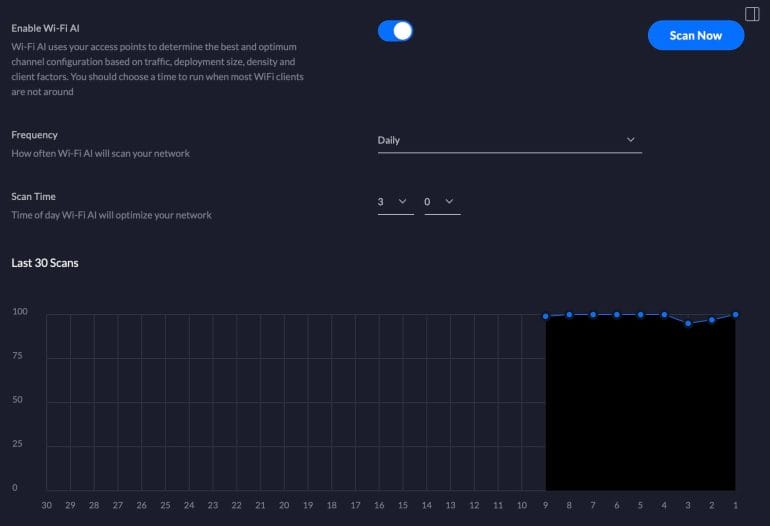
Over the years, AmpliFi has added a lot of advanced features (such equally a VPN server) that used to only exist available in concern-grade equipment.
While that has certainly closed the gap a bit to what UniFi offers, at that place is even so a major difference between the two technologies.
The scope of this article isn't big enough to compare every single characteristic, and so I'm picking a limited set of related features to illustrate what UniFi offers over AmpliFi.
Deep Packet Inspection (DPI), Intrusion Detection (IDS) and Intrusion Prevention (IPS) are advanced security features that the UniFi Dream Automobile can deliver at speeds of up to 1 Gbps, thanks to its powerful hardware.
I value those features because they give me better insight into what's going on in my network, specifically as I continue calculation more than devices that act like a blackbox. I'm talking nearly smart habitation devices, such as light switches, door locks, etc.
Since I don't necessarily trust all manufacturers with implementing all-time-practice network security in their devices, I appreciate that I tin can isolate them from my main network and use DPI and IDS to understand what they're doing and to get notified if they're doing something fishy.
My recommendation: This one is easy. If you know what y'all're doing and you demand detailed control over avant-garde networking features, go with UniFi. If you don't know or don't care what a VLAN is, stick with AmpliFi.
Central Direction

If your goal is to deploy ii or three wireless access points throughout your dwelling house or business, yous probably don't need a key direction console.
I have seven UniFi devices on my network and I don't really demand a fundamental management dashboard. But I like having it — especially because of the reporting features. It'south cool to see how much traffic I produce and what devices and apps transfer the most data.
Once more, it's not something I couldn't alive without but I capeesh having a visual representation of my network.
My recommendation: If you lot plan on deploying dozens of admission points, switches and routers, y'all desire UniFi and its central management capabilities. If your network won't need more than a scattering of devices, the AmpliFi mobile app is likely more than plenty for y'all.
Frequently Asked Questions
Does UniFi work with AmpliFi?
That depends on your definition of "work." Y'all cannot mix and match UniFi and AmpliFi devices to create a mesh network. But you lot certainly could utilize a USG and UniFi switch in combination within an AmpliFi Conflicting.
However, you won't be able to manage the Alien using the UniFi Controller. So while such a mixed scenario is possible, it'south clunky and has some technical limitations.
Can AmpliFi act as a DHCP server?
Yep, AmpliFi routers can act as both a DHCP customer and DHCP server. Needless to say, so tin UniFi.
Can I create a mesh network with UniFi?
Yes, you tin can certainly create a mesh network using UniFi access points. In fact, the handover and roaming capabilities outperform those you tin can notice in AmpliFi.
What's the best AmpliFi or UniFi Wi-Fi router?
The best AmpliFi Wi-Fi router is the AmpliFi Alien and the best (and merely) access point/router combination UniFi offers is the UniFi Dream Motorcar.
Can both AmpliFi and UniFi create a guest network?
Yes, with AmpliFi you can create one guest network. UniFi offers support for multiple Wi-Fi networks — including invitee networks. You lot're only limited past the number of networks each access indicate supports.
Exercise both AmpliFi and UniFi have a mobile app?
Yes, both brands offer mobile apps but there are differences as far every bit capabilities are concerned. The AmpliFi app is your primary configuration tool considering AmpliFi doesn't have a powerful web interface.
With UniFi, you make all configuration changes using a web interface and the app is simply a reporting and viewing tool that doesn't allow you to brand configuration changes.
Both apps work on iOS and Android devices.
Is a mesh network ameliorate than a Wi-Fi extender (or range extender)?
Aye, Wi-Fi or range extenders reduce the functioning of your wireless network. Mesh networks don't accept that trouble, and are thus superior as far as performance and reliability are concerned.
How does AmpliFi compare to other mesh networking technologies?
Check out my dedicated AmpliFi review for more than data about how the technology compares to Eero, Linksys Velop and others.
How does the UniFi Security Gateway compare to Ubiquiti's EdgeRouter Lite?
Bank check out my dedicated UniFi review for more information near how UniFi compares to EdgeMax.
Does UniFi offer parental controls?
While you tin can create your ain firewall rules that mimic the parental controls that AmpliFi provides, there are no pre-defined rules or parental controls in UniFi.
AmpliFi vs. UniFi: Conclusion
Ubiquiti's AmpliFi line of products offers excellent performance and reliability to go spotless WiFi coverage in your home.
Merely if you're tech-savvy and enjoy pushing your equipment to its limits, I highly recommend taking a look at Ubiquiti'due south reasonably-priced UniFi product line.
UniFi offers business-class performance and flexibility that yous commonly don't see in products at that toll betoken. While the configuration of UniFi devices is a bit more than involved than that of AmpliFi, information technology's not rocket science and you lot'll appreciate the boosted reporting, analytics, and control it provides.
What's your accept on AmpliFi vs. UniFi? Do you take experience with both? Allow me know by leaving a comment below.

I'thousand a healthy living and technology enthusiast.
On this blog, I share in-depth product reviews, actionable data and solutions to complex problems in plain and easy-to-sympathise linguistic communication.
Source: https://michaelkummer.com/tech/amplifi-vs-unifi/
0 Response to "Uverse Is Not Available at This Time Please Try Again Later"
Post a Comment